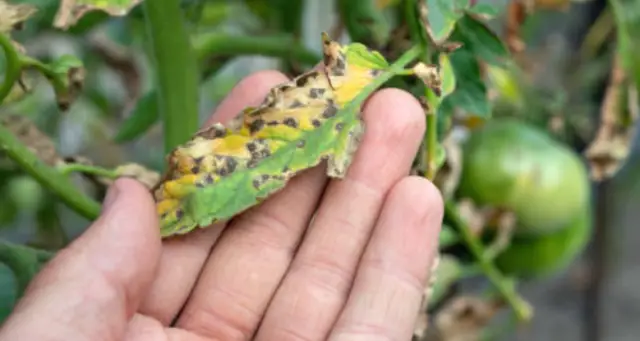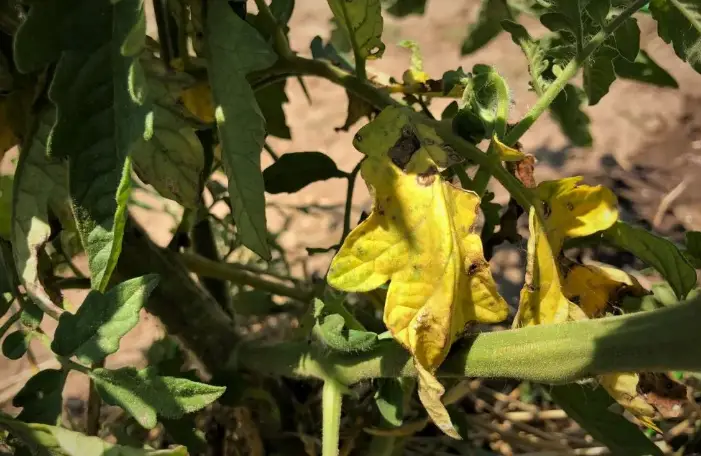Why are your tomato leaves turning yellow and how to fix it?
Tomato plants are one of the most popular crops for home gardeners, but they can also be prone to various problems that affect their health and productivity. One of the most common issues is yellowing leaves, which can indicate a range of causes and solutions. In this post, we will explore some of the reasons why your tomato leaves are turning yellow and how to prevent or treat them.
Causes of yellowing leaves on tomato plants

Yellowing leaves on tomato plants can be caused by:
- Watering issues: Too much or too little water can stress the plants and wash away or limit the availability of nutrients, especially nitrogen. Tomatoes need nitrogen for good leaf growth and to support photosynthesis. To avoid watering issues, check the soil moisture regularly and water only when the top inch of soil feels dry. Use pots with drainage holes, and avoid overwatering or letting the pots sit in water.
- Nutrient deficiencies: Besides nitrogen, tomatoes also need other nutrients such as phosphorus, potassium, calcium, magnesium, iron, and more. A lack of any of these nutrients can cause yellowing leaves, as well as other symptoms such as stunted growth, blossom end rot, leaf curling, or spots. To prevent nutrient deficiencies, use a balanced fertilizer that contains all the essential nutrients for tomatoes and follow the label instructions. You can also use organic amendments such as compost, manure, or worm castings to enrich the soil.
- Pests or diseases: Some pests or diseases can attack tomato plants and cause yellowing leaves, as well as other damages such as holes, spots, wilting, or deformities. Some common pests or diseases that affect tomatoes are aphids, spider mites, whiteflies, leaf miners, caterpillars, nematodes, blight, mosaic virus, wilt, or root rot. To protect your plants from pests or diseases, inspect them regularly and remove any infected or damaged parts. Use organic or natural methods to control pests, such as neem oil, insecticidal soap, or diatomaceous earth. Avoid planting tomatoes near other plants that can harbor pests or diseases, such as potatoes, peppers, or eggplants. Rotate your crops every year to prevent soil-borne diseases.
Here is a Table on Yellowing Leaves on Tomato Plants in Pots:
| Cause | Symptoms | Solution |
|---|---|---|
| Overwatering | Leaves turn yellow and wilt, roots rot, fungal diseases | Water only when the top inch of soil is dry, improve drainage, use a moisture meter or a self-watering pot |
| Underwatering | Leaves turn yellow after wilting, blossom end rot, reduced fruit size | Water deeply and regularly, mulch the soil, use a moisture meter or a self-watering pot |
| Nutrient deficiency | Leaves turn yellow from the bottom up, purple veins, stunted growth, poor fruit quality | Fertilize with a balanced fertilizer for tomatoes, use organic amendments, test and adjust the soil pH |
| Pests or diseases | Holes, spots, wilting or deformities on leaves or fruits, insects or fungal growth | Use organic or natural methods such as neem oil, insecticidal soap or diatomaceous earth, remove infected or damaged parts, avoid planting near susceptible plants |
| Sunlight deprivation | Leaves turn yellow from the bottom up, spindly stems, reduced fruit production | Place pots in a sunny spot that is not shaded by buildings or trees, use reflective materials to increase light intensity |
| Transplant shock | Leaves turn yellow and wilt soon after transplanting, slow recovery | Transplant when the plants are young and healthy, choose a larger pot with drainage holes, use fresh potting soil with organic matter and pH of 6.0 to 6.8, water well after transplanting |
| Temperature stress | Leaves turn yellow and curl up or down, blossom drop, reduced fruit set | Protect plants from extreme heat or cold, use row covers or cloches in early or late season, water well in hot weather |
| Natural aging | Leaves turn yellow and die from the bottom up as the plant matures and fruits ripen | Prune or remove old leaves to improve air circulation and light penetration, fertilize with a low-nitrogen fertilizer to encourage fruit development |
How to fix yellowing leaves on tomato plants

If you notice yellowing leaves on your tomato plants, don’t panic. There are some steps you can take to fix the problem and restore your plants’ health:
- Identify the cause: The first step is to identify the cause of the yellowing leaves by observing the symptoms and checking the environmental conditions. Look for signs of watering issues, nutrient deficiencies, pests, or diseases and compare them with online resources or guides. You can also use a soil test kit to check the pH and nutrient levels of your soil.
- Correct the problem: The next step is to correct the problem by adjusting the watering schedule, applying fertilizer, transplanting to a larger pot, aerating the soil, pruning or staking the plants,, or treating the pests or diseases. Depending on the severity of the problem, you may need to take one or more of these actions to fix it.
- Monitor the results: The final step is to monitor the results and see if your plants recover from the yellowing leaves. It may take some time for the plants to show signs of improvement, so be patient and consistent with your care. If you don’t see any positive changes after a few weeks, you may need to repeat the steps or try a different solution.
Conclusion
Yellowing leaves on tomato plants in pots are not uncommon and can be caused by various factors,, such as watering issues, nutrient deficiencies, pests,, or diseases. However, with proper identification and correction of the problem, you can fix it and enjoy healthy and productive tomato plants.
I hope this blog post outline was helpful for you. If you have any questions or feedback, please let me know in the comments below.
https://ecofamilylife.com/garden/tomato-seedlings-turning-yellow-8-reasons-and-easy-solutions/
https://dengarden.com/gardening/Yellow-leaves-on-tomato-plants-Get-rid-of-yellow-tomato-leaves
https://agrilifetoday.tamu.edu/2021/04/19/why-are-my-tomato-leaves-turning-yellow/
FAQ on yellowing leaves on tomato plants in pots:
-
Q: Why are my tomato leaves turning yellow?
- A: There are many possible causes of yellowing leaves on tomato plants, such as watering issues, nutrient deficiencies, pests or diseases, sunlight deprivation, transplant shock, temperature stress, or natural aging.
-
Q: How do I know if I am overwatering or underwatering my tomato plants?
- Overwatering can cause the leaves to turn yellow and wilt, as well as cause root rot and fungal diseases. Underwatering can cause the leaves to turn yellow after wilting, as well as blossom end rot and reduced fruit size. To check the soil moisture, insert your finger into the soil up to the second knuckle. If it feels wet, you are overwatering. If it feels dry, you are underwatering.
-
Q: How often should I water my tomato plants in pots?
- There is no fixed rule for how often to water tomato plants in pots, as it depends on factors such as the pot size, soil type, weather conditions, and plant size. A general guideline is to water only when the top inch of soil feels dry to the touch. You can also use a moisture meter or a self-watering pot to monitor the moisture in the soil.
-
Q: What nutrients do tomato plants need, and how do I provide them?
- A: Tomato plants need a balanced fertilizer that contains nitrogen (N), phosphorus (P), potassium (K), and other micronutrients such as calcium (Ca), magnesium (Mg), iron (Fe), and more. You can use a commercial fertilizer that is specially formulated for tomatoes and follow the label instructions. You can also use organic amendments such as compost, manure, or worm castings to enrich the soil.
-
Q: How do I identify and treat pests or diseases on my tomato plants?
- Some common pests or diseases that affect tomato plants are aphids, spider mites, whiteflies, leaf miners, caterpillars, nematodes, blight, mosaic virus, wilt, or root rot. You can identify them by looking for signs such as holes, spots, wilting, or deformities on the leaves or fruits. You can treat them by using organic or natural methods such as neem oil, insecticidal soap, or diatomaceous earth. You can also remove any infected or damaged parts and avoid planting tomatoes near other susceptible plants.
-
Q: How much sunlight do tomato plants need, and how do I provide it?
- A: Tomato plants need at least 6 to 8 hours of direct sunlight per day to grow well and produce fruits. You can provide it by placing your pots in a sunny spot that is not shaded by buildings or trees. You can also use reflective materials, such as aluminum foil or white plastic, to increase the light intensity.
-
Q: When should I transplant my tomato plants to a larger pot, and how do I do it?
- You should transplant your tomato plants to a larger pot when they outgrow their current one or when they start to show signs of stress such as yellowing leaves, stunted growth, or reduced fruit production. You can do it by choosing a pot that is at least twice the size of the current one and has drainage holes. You can also use fresh potting soil that is rich in organic matter and has a pH of 6.0 to 6.8. You can gently loosen the root ball of the plant and place it in the new pot. You can fill the gaps with more soil and water.
-
Q: How do I aerate the soil of my tomato plants in pots, and why is it important?
- You can aerate the soil of your tomato plants in pots by using a fork or a stick to poke holes in the soil every few weeks. This will help improve the drainage and oxygen availability of the soil, which is important for healthy root growth and nutrient uptake.
-
Q: How do I prune or stake my tomato plants in pots, and why is it beneficial?
- A: You can prune or stake your tomato plants in pots by removing any suckers (side shoots) that grow between the main stem and the branches. This will help reduce overcrowding and improve air circulation and light penetration. You can also use stakes, cages or trellises to support your plants and prevent them from falling over or breaking under their own








